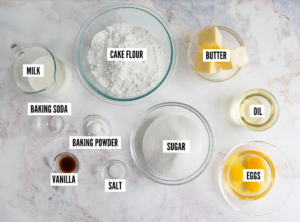Everyone Loves Cakes! Here Is How To Achieve A Moist And Fluffy Cake Part1

Cake is a form of sweet dessert that is baked. In its oldest forms, cakes were modifications of bread, but cakes now cover a wide range of preparations that can be simple or elaborate.
 |
| A fluffy Vanilla Cake |
Making a cake is not a difficult process, but complications can arise whether you are using a premixed product or baking the cake from scratch. By altering the ingredients, however, you can eliminate several potential pitfalls that lead to a cake being dry and crumbly when it comes out of the oven. In some cases, making substitutions or adding one additional element is all you need to make an extremely moist and fluffy cake.
Please note that a cake can be fluffy and not moist. It is thus beneficial for you to know exactly what you want to achieve in order for the rules below to guide you.
Let’s dive into the rules;
WORK WITH A RECIPE
This action cannot be overemphasized. Baking is as much an art as it is a science. To
achieve dependable results, we need to work with recipes and not take guess work. Unlike
in times past when we baked merely based on what comes into our heads. If a recipe must be changed during baking, take note of those changes. That way you know what to repeat or
avoid the next time you are baking that type of cake.
TYPE OF CAKE
Some types of cakes like red velvet cakes and carrot cakes are naturally moist and in fact, cakes with high liquid proportions always turn out moist. Sponge cakes are naturally fluffy while vanilla cakes are usually not as moist and fluffy.
 |
| An Array of Different Cakes |
Knowing what to expect from a particular type of cake and having good knowledge of the characteristics of various types of cakes is thus an asset that would help you make a verdict on the type of cake that will fit your objective.
CHOICE OF INGREDIENTS
The type of ingredients you use to bake your cakes plays a major role in how fluffy and moist
your cake will be. Let’s consider these few tips below:
 |
| Vanilla Cake Ingredients |
(i) Use cake flour in place of all-purpose flour. Cake flour is flour that has been mixed with
some corn starch in order to make it lighter. Cakes baked with cake flour are usually lighter
and softer than cakes baked with all-purpose flour.
(ii) Use real butter in place of margarine, even if the recipe calls for it. Margarine or butter
substitutes contain more water than fat. However, it is the fat in the butter that helps to hold the cake together and moisten it. The excess water in the margarine will evaporate in the oven’s heat, leaving you with a dry texture to your cake.
(iii) Substituting some butter with oil in a recipe always leads to moistening cakes. Vegetable oil
reduces the production of gluten in the flour, a protein found in wheat products that work as a
binding agent. Too much gluten in a cake will cause it to be sticky rather than moist.
(iv) Consider substituting milk for buttermilk. Buttermilk has a high acidic content which
breaks down the gluten in the flour, thus making cakes softer. If you are going to use buttermilk
in a recipe that does not include baking soda, consider adding a little bit of baking soda to
the recipe.
(v) Blend the batter thoroughly after adding any additional ingredients called for in the recipe
to ensure their full incorporation and then bake the cake normally.
 |
| Cake Barter Being Mixed |
Part 2 Coming Soon😎😋
